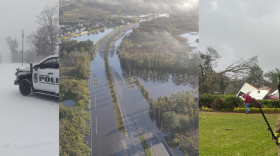Lee County leaders are trying to decide what to do with the hurricane-damaged Little Pine Island Bridge and other transportation projects.
Commissioners met recently with Lee County Manager Roger Desjarlais, Deputy County Manager Dave Harner and Transportation Deputy Director Rob Price to discuss these projects.
For the Little Pine Island Bridge, FDOT and county planners want to either add new seawalls to the existing bridge or entirely replace the structure. The bridge was built in 1977 and Hurricane Ian caused significant soil loss, loss of the seawalls and approach slabs on both sides of the bridge.
“The county had identified some repairs in our inspection of the bridge in 2021 and we brought forward an agenda item for $150,000 worth of repairs on April 5, 2022 to the board meeting,” Price said. “Subsequently, FDOT did another inspection in August of 2022, which indicated the bridge qualified for replacement. We were in the process of completing those repairs that were awarded by the board when Hurricane Ian happened last fall.”
After Ian the bridge was temporarily rebuilt to allow residents and emergency response teams to get to Pine Island by vehicle. The bridge is the only roadway link between the mainland and the island. Crews removed the old approach slabs and laid temporary asphalt.
Hannah Holloway of Saint James City calls Pine Island her home. She was at school in Georgia when Hurricane Ian hit, but her family was still on the island; Her parents left just hours before the storm hit and sheltered at her brother’s house in Cape Coral.
“As soon as the storm was over, they got my sister's boyfriend and they hopped on the boat and went home because obviously, the bridge was no more,” Holloway said.
She said they’re more fortunate than others because the house still was standing. The surge brought in a foot of water and left a layer of sludge.
Holloway said she hopes the county will find the money to build a new bridge that can withstand another hurricane.
“I guess a temporary fix would have to do but it's just scary when hurricane season is right around the corner and the same thing could happen again, or even worse,” she said.
Option A is to keep the existing bridge, add new seawalls and replace the first and last spans of seawall. The estimated cost is $4.35 million.
County planners said the pros of this option are that it’ll take only six months of work, no barges are needed to perform work, fewer permits are needed and it's the less expensive plan.
The cons are that the bridge is vulnerable to future storms and the repair work will be lost when the bridge is replaced in a few years. Another negative is that one lane of the bridge will last only six months after repairs.
“Upon completion of repairs under Option A, this bridge would still require full replacement in 2027 as previously scheduled, at a cost estimated at $14 million,” Price said.
Option B is to replace the existing bridge and seawalls. The estimated cost is $7.65 million and the county share is $4.17 million. The pros are that it’s the most durable option to withstand future storms and it accommodates a planned shared use path. The cons are that construction will take longer and require more permits than option A.
“If we’re going to be committed to resiliency, we need to go there,” Commissioner Kevin Ruane said. “It really doesn’t seem to be much of a decision from my point of view.”
Commissioner Brian Hamman suggested the county discuss the two options with Pine Island and Matlacha residents. He said people should know about traffic delays and other issues that will occur during work on either option.
Lee road planners ranked the other transportation projects based on need, safety and funding, along with a few additional criteria.
“These tier one projects include projects that are already in our five year capital improvement program. In addition to the projects that we anticipate delivering in the next 10 years,” Price said.
The Little Pine Island Bridge is the only new project moved to tier one. Tier two projects are expected to be completed in a 10-to- 20-year range. Tier three projects are expected to be completed in a 20-to-30- year range.
“When I look at the tier one projects, I would like to make sure that we focus really heavily on projects that add capacity and relieve congestion,” Hamman said. “I think it's important to do projects that are maintenance-related like the repaving program, like the bridge replacements and while those are super necessary for safety reasons, it's also hard to hear complaints every day about congestion and not try to put our money there.”
The candidates for federal funding are the Hickory Bridge replacements, Midpoint Bridge project, Burnt Store Road work and the Cape Coral Bridge replacement.
Commissioner Hamman said the county board will make a decision on the Little Pine Island Bridge at a future meeting.
This story was produced by the Democracy Watch class in the FGCU Journalism program. Hayley Lemery can be reached at hklemery9681@eagle.fgcu.edu
WGCU is your trusted source for news and information in Southwest Florida. We are a nonprofit public service, and your support is more critical than ever. Keep public media strong and donate now. Thank you.










